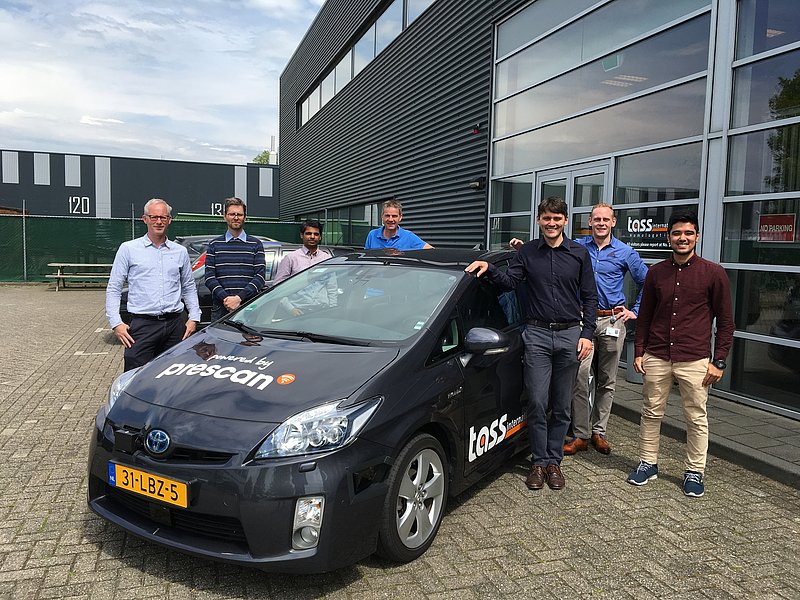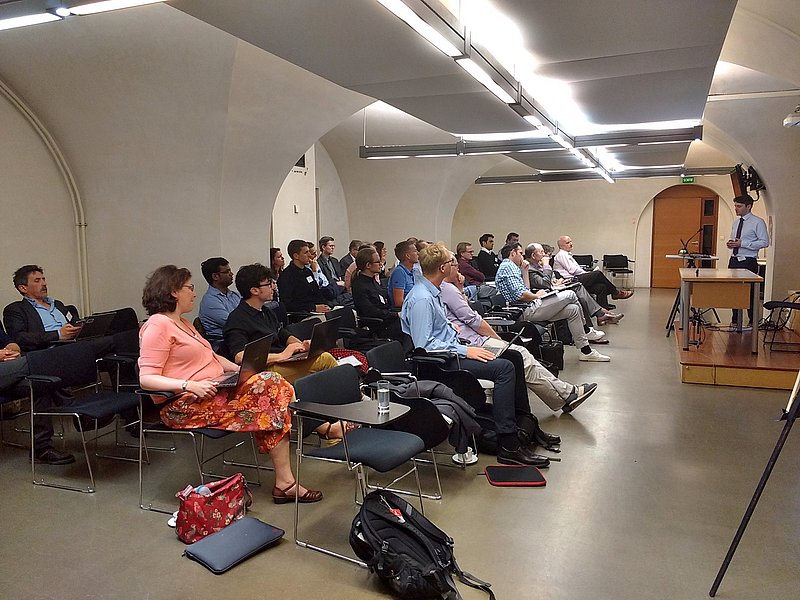
CoEXist kick-off meeting group picture© CoEXist, 2017

Group photo with one of the TASS automated vehicles that is to be used for data collection in CoEXist© Rupprecht Consult, Bernard Gyergyay, 2017

Bernard Gyergyay (Rupprecht Consult) delivering a presentation on developing a CAV-ready framework© CoEXist, 2017

Computer simulation of mixed traffic in an urban environment© Rupprecht Consult, Syrus Gomari, 2017
The mission of CoEXist is to systematically increase the capacity of road authorities and other urban mobility stakeholders to get ready for the transition towards a shared road network with increasing levels of connected and automated vehicles (CAVs), both in terms of vehicle penetration rates and levels of automation using the same road network as conventional vehicles (CVs). CoEXist will enable mobility stakeholders to get “Automation-ready” – which CoEXist defines as conducting transport and infrastructure planning for automated vehicles in the same comprehensive manner as for existing modes such as conventional vehicles, public transport, pedestrians and cyclists, while ensuring continued support for conventional vehicles on the same network.

Duration 05/2017 – 04/2020
Website http://www.h2020-coexist.eu
Coordinator Rupprecht Consult GmbH
CoEXist’s strategic aim was to bridge the gap between connected and automated vehicles (CAVs) technology and transportation and infrastructure planning by strengthening the capacities of urban road authorities and cities to plan for the integration of CAVs in the same network.
Automation-ready transport and infrastructure planning in cities is a key precondition for fulfilling the promises of CAVs to reduce road space demand and improve traffic efficiency and safety. CoEXist will address three key steps in transport and infrastructure development:
CoEXist developed a trans-disciplinary approach to the deployment of CAVs on urban road networks by bringing together leading networks for vehicle research (iD4Car), road research (FEHRL) and urban mobility (Polis) to conduct a stakeholder engagement process with leading organisations in the field. All results are summarised in a "Automation-ready framework" for road authorities and feed into the development of automation roadmaps (e.g. FEHRL Forever Open Roads).
CoEXist fostered technological development of microscopic and macroscopic modelling tools, CAV-simulators and CAV control logics. It created a closed-loop connection between AV control logics (provided by Renault and Vedecom), an AV- simulator (PreScan) and the microscopic modelling tool Vissim. This connection facilitated the definition of vehicle behaviour parameter sets for microscopic simulation models. The models were validated with real-life AVs on the public test track operated by TASS International in Helmond, The Netherlands. CoEXist enhanced the existing micro- and macroscopic models Vissim and Visum starting at Technology Readiness Level 2, i.e. TRL 2 (technical concept of the integration of AV-ready transport into modelling tools), and validated them in relevant modelling environments (TRL 5 to TRL 8). Eventually these were released to the competitive environment (TRL 9) by the end of the project.
In CoEXist, Renault and Vedecom simulated their CAVs in four different European road authorities (Gothenburg, Helmond, Stuttgart and Milton Keynes) with very different urban structures and traffic compositions. With the initial model-based assessment of the AV control logic, significant time and costs can be saved in order to reach TRL 9. Findings from CoEXist were applied further by OEMs to simulate their AVs in other cities, provided they had access to the transport models.
CoEXist helped to better understand the effect of CAVs on urban road infrastructure, especially during the transition phase. The project analysed eight use cases (e.g. capacity of arterial road with signalised junction, mixed road space) in Gothenburg, Helmond, Milton Keynes and Stuttgart. The CoEXist Automation-ready modelling and impact assessment tools enabled road authorities to understand in detail the impact of increasing numbers of CAVs and of increasing automation levels on a shared (AV/ CV) road network. Through them, the "tipping point" can be identified: at which level of AV penetration and in which transport context do AVs produce relevant transport impacts, requiring road infrastructure adaptations. Each road authority in CoEXist produced an ‘Automation-ready Action Plan’ that gives detailed guidance on steps the road authorities have to take to conduct Automation-ready transport and infrastructure planning.
We were the coordinator of the CoEXist project and responsible for the overall project management (WP6), including administrative and financial management. Apart from the coordination, we also lead work package 1 (WP1): Automation-ready Framework development, and work package 4 (WP4): demonstration of CoEXist tools in road authorities.
Daniel Franco
+49 176 47367054
d.franco@rupprecht-consult.eu